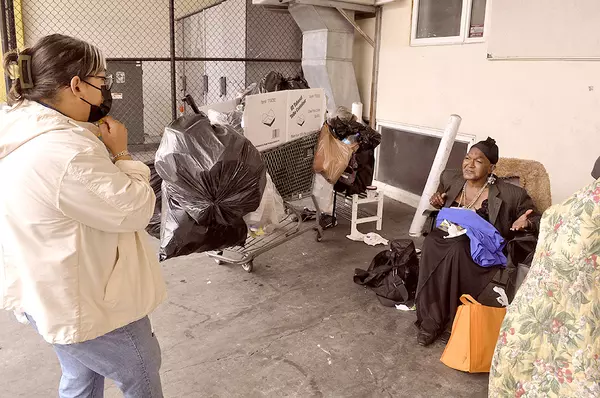
San Diego teens are working less. Why?
By MARK ALLEN CUSome remember a time when teenagers filled malls across San Diego—and more often than not, they were the workers flipping patties and organizing clothes. In fact, most Americans aged 16-19 participated in the labor force in 2000, with retail jobs being the most common pastime for students after school and during summers.However, just two decades later, statistics show that only about 1 in 3 students in San Diego are a part of the workforce, a number that has been steadily declining since 2000. When analyzing this decrease in workers, it is important to note that San Diego teenagers are not necessarily seeing higher unemployment rates (those seeking work but not finding it), but rather, a smaller percentage of students looking for a job in general. Essentially, high school students in San Diego are becoming more hesitant to fill out job applications as time goes on.Mater Dei Catholic student Catalina, 17, spent much of her senior year working in a fast-food chain near her school. “It just hit me that I’m going to college and I need money to pay for tuition and applications — it’s really expensive,” she shared. For many students like Catalina, increasing college expenses create a necessity to earn money before graduating. However, the inflated cost of tuition is also causing many high school students to leave their jobs or choose not to have one. As Catalina explained, “the costs of [my college], are so expensive. The amount of money I saved wouldn’t make much of an impact.”Ironically, the reason some high school students are no longer interested in having a job is that they cannot afford it — not in terms of money, but rather time. Dr. Daniel Enemark, Senior Economist for the San Diego Workforce Partnership, discussed this economic choice that many teenagers make while in school.“In a world where high school becomes a race to get into a college, it becomes an arena to try to prove yourself to get into an elite college.” As he stated, school and extracurriculars have become a full-time job for many students as the competition for college acceptances and by extension, high-salary white-collar work, has increased.Additionally, with overwhelming tuition fees in recent decades, the money earned from a part-time job rarely has any impact on alleviating the cost of college. As Dr. Enemark put it, “The value of a part-time job is lower because the opportunity cost of boosting your resume is higher, meaning that time spent working retail could instead be used to study and get better grades — things that would increase your chances of getting into good universities.” Here, one can see that any economically rational teenager would choose other resume-building activities over joining the workforce.However, this freedom to focus on school rather than getting a job is not evenly distributed across class. Students that come from higher-income families do not have to consider work as the student already has their financial needs accounted for. On the other side, high school students that come from lower-income families do have to consider the prospect of joining the workforce to support their households. This is what makes San Diego’s lack of high school workers unique; our county’s high median household income demonstrates this ability that many students have to not worry about earning money for their families. San Diego families are more likely to have the economic resources and comfortability to have their kids concentrate on their academics and extracurriculars.The underlying concerns of teenagers not having the experience of working entry-level part-time jobs lies in the missed opportunities to learn many crucial life skills while in high school.High Tech High student Madilyn, 17, cites that her three jobs have given her “well-rounded skills and qualities and mature outlooks on life” that have made her better prepared for college life. Olympian High School student April, 18, talked about how the food industry gave her “tough skin” and how she learned to “interact with all sorts of different people and perspectives from both customers and coworkers.” As the disparity between working and non-working San Diego students increase, many teenagers in our county lose the learning opportunities that a job provides.— Mark Allen Cu is a freelance journalist and a student at Stanford University.The post San Diego teens are working less. Why? appeared first on SDNews.com.

San Diego’s growing homelessness crisis takes its toll
By J.M. GARCIAOn a recent, overcast afternoon, James Wheat stood beside his white pickup outside the Hillcrest DMV on Normal Street and reflected on his life with outreach workers from the nonprofit, People Assisting the Homeless (PATH).A self-employed handyman, Wheat saw his jobs dry up during the COVD lockdown. He still dresses for work. On this day, he wore a white, long underwear shirt, dark jeans and work boots. His light brown hair fell evenly to his shoulders, his goatee neat and trim. He has been living in his truck since November 2021 and helps the DMV staff keep the sidewalk clear of other homeless people, an irony he recognizes with a self-depreciating grin.He has always worked for himself. He has a criminal record, breaking and entering, that sort of thing, to support a crack habit, he kicked 20 years ago. Every morning, he walks to a nearby gas station to clean up. A convenience store supplies him with coffee. He was raised in an orphanage and blames that experience for his poor memory with names. No one was ever around long enough for him to remember them. But he enjoys talking when the opportunity arises. Not too many peo-ple, however, show interest in a man who to all appearances looks as if he’s part of the crowd waiting to enter the DMV.One of the outreach workers, Brian Gruters, told Wheat that PATH might be able to enroll him in a construction training classes. Wheat said he would be interested and gave Gruters one of his handyman cards: Handyman Servies-Painting-Tile-Repairs-Remodeling. Free estimates. Senior discounts. Gruters promised to get back to him.“I’m always here,” Wheat, 59, said.Wheat is among the thousands of San Diegans who have no permanent place to live. A recent cen-sus found that almost 8,500 men, women and children live in shelters or outside throughout the county, a 10% jump from 2020. Housing costs continue to be a major obstacle for getting people like Wheat off the street, Gruters said.“Inaccessibility of housing is a major issue,” Gruters said. “Once in housing, with support, the re-tention rate is very high. Even with alcohol and mental health issues, those problems become much more solvable if the person has a place to live.”The aging population of homeless people has made an intractable even more difficult, Gruters con-tinued.“We’re seeing chronic health issues,” he said. “Some of these people can’t go to shelters because of mobility problems and incontinence issues. They’re on fixed income and can’t afford housing. Some of the cheaper single room occupancy hotels aren’t disability accessible.”PATH outreach worker, Gabriella Ledezma, talks to Kim Chow who has been homeless for nine years due to depression. (Photo by J.M. Garcia)Gruters and his two colleagues, outreach specialists Gabriella Ledezma and Nate Dressel, walked past the DMV toward Newbreak Church on Normal Street. Around a corner, about half a block down, an elderly man appeared asleep on a patch of grass beside a shopping cart, a blue box of ce-real poking out of it. Ledezma recognized him. She said he was kind and smart and suffered from Schizophrenia. Despite his problems, he would express gratitude when she stopped to talk to him and offer him food and a hygiene kit. When he was not hallucinating, he would talk and ask her how she was.“Many homeless people aren’t used to having people who will talk and listen to them,” Ledezma said. “As you gain trust, they will share more, trust more. I just let the conversation flow until it ends naturally.”Another, younger man stood with a thin, scrappy beard stood close by. He wore a long, stained trench coat and held two stuffed plastic bags that held among other things a bottle of Gatorade and duct tape. He rummaged in his pockets with his free hand and spoke to himself. Ledezma of-fered him a hygiene kit. The man asked if she knew where he could take a shower.“What’s your name?” Ledezma asked.“Retired,” the man replied, and smiled.“Are you interested in shelter?”“Yes.”“We can help with that,” Ledezma said. “As long as we know where to meet you, we can get you in a shelter. Do you know where you’ll be tomorrow?”“Here.”Recently, PATH staff have received calls from hotels with families on the verge of homelessness. Mom and kids out of rent money, can you help? Gruters and his colleagues have seen an increase in single mothers and their children living in cars and tents.“There is a need for preventive measures to help in these kinds of situations,” he said, “before they land on the street.”Not far from Newbreak Church, Kim Chow and Damon Hart sat in an alley behind a store with a shopping cart loaded with garbage bags stuffed with cans to recycle. A dumpster stood off to one side reeking of garbage, the concrete around it slimy with ground-in trash.Chow, 66, had on a black dress with a necklace. Ledezma gave her a blue dress.“It’s cute,” Chow said. “Nice color.”“Have you seen, Joe?” Ledezma asked, referring to a homeless man she knows.“He’s across the street,” Chow said.She has been homeless for nine years. Depression, she said, put her on the street.Hart, 60, stared at the outreach workers from behind dark sunglasses. He ran a hand through his gray hair he had tied off in a ponytail and he tugged at a blue kerchief around his neck. Hunched over from arthritis in his spine, he turned his head when spoken to but tried not to move the rest of his body. He has been without a home for four months. He complained that security guards of-ten roust him and other unsheltered people. When he gets kicked out of Hillcrest, he goes to Mis-sion Hills. He returns to Hillcrest when he can no longer stay in Mission Hills.“I’m tired,” he said.Homeless people, Dressel said, consider Hillcrest a safe area. Parts of Downtown, too, are deemed safe like City Center and C Street near the trolley between 9 p.m. and 5 a.m. But they have to leave in the morning. Their plight takes a toll.“This work is emotionally intense,” Dressel said. “You care about a lot of people out here. You want to help. You do your best but you hear word of mouth that someone died. It’s tough. You’re not always prepared for it. But it’s a real high when you get someone into housing.”The post San Diego’s growing homelessness crisis takes its toll appeared first on SDNews.com.

Eclectique Boutique opens in Seaport Village
Eclectique Boutique recently opened in San Diego’s Seaport Village. This amazing boutique is situated in the Lighthouse District and is owned and operated by Gayleen Nichols. Nichols is a longtime Downtown business owner. She operated Bubble’s Boutique for over 17 years in the Gaslamp Quarter District so many of her clients will be delighted to learn that she is remaining in Downtown.One of a kind leather handbags by SorukaThis charming boutique has an amazing industrial chic interior with a beautiful combination of metal and wood. There is an array of unique clothing, accessories and fun gifts. They are especially excited to carry items by local artists such as crystal jewelry by Lorie Smith and Sterling Silver jewelry, Little Sparkles by Mike Pinn.Crossbody Beaded Handbags by Mary FancesThey carry one-of-a-kind leather bags and wallets by Soruka. This company uses leftover scraps of leather to reduce the environmental impact which keeps them out of landfills. This recycled leather creates zero waste.Kate Mesta, is another jewelry artist from Laguna Beach who is in the store. Timmy Woods is a globally-renowned handbag designer and you can find her creative jackets in this store. You may remember her Paris Handbag worn by Sarah Jessica Parker in Sex in the City. One of the standouts are the crossbody beaded handbags by Mary Frances. Some are in the shape of musical instruments, floral bags and crossbody skull handbags. Mary Frances creates handbags that are produced with socially compliant partners.Mona B TowelsVintage Addiction is 100% recycled military tents. Kent Stetson cut up pieces of his computer-generated art and creates special handbags that are a real conversation starter. One of the best-selling gifts are dishtowels with humorous sayings on them. My favorite was “Of course I talk to MY DOG Who else can I trust?” For all the dog lovers out there, you can find many dog-related items such as pet tags by Kate Mesta and Chala Handbags who are an advocate of animal rights and welfare. The bags are PETA-approved vegan and they donate to their charity partner, Heart and Home Animal Rescue Foundation.Jackets by Timmy WoodsThis boutique also carries clothing and one of their best sellers are the Cha Cha pants by Tempo Paris. Another best seller is Silk Kimono’s by Cocoon House. They have a selection of women sizes including extra-large. The tag line is “Eclectique Fashion and Gifts for every Mood.” Starting in June they will have new store hours from 10 a.m. to 10 p.m. For a fabulous shopping experience stop by in Seaport Village Suite # 11 or visit eclectiqueboutique.com.Erin Collins behind the registerUpcoming Events“Fold, Twist, Tie” — This is a Paper Bag Hat exhibit by moses at the Mingei International Museum in Balboa Park. Open 10 a.m.-5 p.m. on Saturday-Wednesday and 10 a.m.-8 p.m. on Thursday-Friday. In conjunction there will be a lecture by Diana Cavagnaro on Hats at Coffee and Conversation which will be on June 24 from 10:30 a.m.-11:30 a.m. at the Frances Hamilton White Art Library. It will be on display April 8 through October 2.June 5, 2022 — San Diego Swim Week Collective — Network, shop and celebrate at The Inn at Rancho Santa Fe from 1-4 p.m. on June 5. For tickets visit: bit.ly/3z652TZThe post Eclectique Boutique opens in Seaport Village appeared first on SDNews.com.
Categories
Recent Posts






![San Diego Whale Watching – Best Tours, Season & Tips [2025]](https://img.chime.me/image/fs/chimeblog/20250211/16/w600_original_5e9fb89f-9e0f-4e9e-a973-6b784b551bf5-jpg.webp)

![Best Korean BBQ in San Diego [2025]](https://img.chime.me/image/fs/chimeblog/20250214/16/w600_original_9684c5e0-09f4-4623-9e32-dcbc61f42e30-jpg.webp)
![28 Fantastic Beach Resorts in San Diego [2025]](https://img.chime.me/image/fs/chimeblog/20250212/16/w600_original_d2642a7b-7003-4a57-9634-7bafb5e625a9-jpg.webp)

